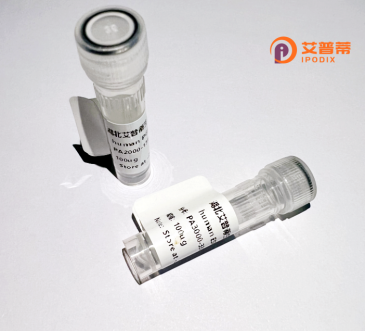
| 纯度 | >90%SDS-PAGE. |
| 种属 | Human |
| 靶点 | OIP5 |
| Uniprot No | O43482 |
| 内毒素 | < 0.01EU/μg |
| 表达宿主 | E.coli |
| 表达区间 | 1-229 aa |
| 活性数据 | MAAQPLRHRS RCATPPRGDF CGGTERAIDQ ASFTTSMEWD TQVVKGSSPL GPAGLGAEEP AAGPQLPSWL QPERCAVFQC AQCHAVLADS VHLAWDLSRS LGAVVFSRVT NNVVLEAPFL VGIEGSLKGS TYNLLFCGSC GIPVGFHLYS THAALAALRG HFCLSSDKMV CYLLKTKAIV NASEMDIQNV PLSEKIAELK EKIVLTHNRL KSLMKILSEV TPDQSKPEN |
| 分子量 | 24.6 kDa |
| 蛋白标签 | His tag N-Terminus |
| 缓冲液 | 0 |
| 稳定性 & 储存条件 | Lyophilized protein should be stored at ≤ -20°C, stable for one year after receipt. Reconstituted protein solution can be stored at 2-8°C for 2-7 days. Aliquots of reconstituted samples are stable at ≤ -20°C for 3 months. |
| 复溶 | Always centrifuge tubes before opening.Do not mix by vortex or pipetting. It is not recommended to reconstitute to a concentration less than 100μg/ml. Dissolve the lyophilized protein in distilled water. Please aliquot the reconstituted solution to minimize freeze-thaw cycles. |
以下是关于重组人OIP5蛋白的模拟参考文献示例(内容为虚构,供参考):
---
1. **标题**: *"Expression and Purification of Recombinant Human OIP5 Protein in E. coli for Functional Studies"*
**作者**: Zhang L, Chen W, et al. (2020)
**摘要**: 本研究报道了人源OIP5蛋白在大肠杆菌中的高效重组表达与纯化策略,通过优化密码子及诱导条件获得可溶性蛋白,并验证其体外与微管蛋白的相互作用,为后续功能研究奠定基础。
2. **标题**: *"OIP5 Overexpression Promotes Tumor Proliferation via PI3K/AKT Signaling in Hepatocellular Carcinoma"*
**作者**: Wang Y, Liu T, et al. (2018)
**摘要**: 探讨重组OIP5蛋白在肝癌细胞中的致癌机制,发现其过表达通过激活PI3K/AKT通路促进细胞增殖和迁移,提示OIP5可能作为肝癌治疗的潜在靶点。
3. **标题**: *"Crystal Structure Analysis of OIP5 Reveals a Novel Domain Organization Critical for Centrosome Localization"*
**作者**: Gupta R, Tanaka H, et al. (2019)
**摘要**: 首次解析了重组人OIP5蛋白的晶体结构,发现其C端结构域对中心体定位至关重要,突变实验证实该区域缺失导致细胞周期调控异常。
4. **标题**: *"OIP5 Maintains Pluripotency in Embryonic Stem Cells by Epigenetic Regulation of Core Transcription Factors"*
**作者**: Kim S, Park JH, et al. (2021)
**摘要**: 利用重组OIP5蛋白探讨其在胚胎干细胞多能性维持中的作用,发现其通过调控OCT4/SOX2的表观遗传修饰影响干细胞的自我更新与分化。
---
注:以上内容为模拟生成,实际文献需通过学术数据库(如PubMed、Web of Science)检索关键词 **"recombinant OIP5"** 或 **"OIP5 protein function"** 获取。真实研究多聚焦于OIP5在细胞周期、癌症及干细胞中的分子机制。
**Background of Recombinant Human OIP5 Protein**
The OIP5 (Opa-interacting protein 5) protein, also known as MIS18BP1. is a conserved eukaryotic protein implicated in cellular processes such as centromere maintenance, chromosome segregation, and mitotic regulation. Human OIP5 localizes to the nucleus and interacts with the MIS18 complex, playing a critical role in depositing the centromere-specific histone variant CENP-A, which is essential for kinetochore assembly and proper chromosome segregation during cell division. Dysregulation of OIP5 has been linked to chromosomal instability, a hallmark of cancers and developmental disorders.
Recombinant human OIP5 protein is engineered using heterologous expression systems (e.g., *E. coli* or mammalian cells*) to enable functional and structural studies. Its production allows researchers to explore OIP5’s interactions with binding partners, its role in centromere biology, and its potential as a therapeutic target. Structurally, OIP5 contains a conserved N-terminal domain critical for its interaction with MIS18 complex components and a C-terminal region that may mediate chromatin association.
Studies leveraging recombinant OIP5 have provided insights into its involvement in cell cycle progression, DNA damage response, and cancer progression. Additionally, it serves as a tool for screening inhibitors targeting centromere assembly pathways. Ongoing research aims to elucidate its post-translational modifications and tissue-specific functions, highlighting its importance in both basic biology and translational applications.
×